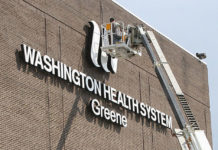the human eye, making the screening process efficient, she said. “We have been going to various facilities and doing week-long or three-day long demos of the instrument so that jail administrators get a chance to see it in person and see its ability to detect these substances of interest — whether it’s a drug or a cutting agent.”
Currently, VeroVision can screen drugs such as suboxone, heroin, methadone, methamphetamines, cocaine, ketamine and PCP. The detectable cutting agents are caffeine, lidocaine, procaine, phenacetin, DMSO and baking soda.
“The product was developed because of a need,” Tiberio said. “When our technology is able to show them something they haven’t been able to see, it’s a really powerful moment.”
The portable machine specifically detects hidden substances in paper or photos, improving the safety of correctional facilities; it features a one-button-touch interface allowing easy use for personnel, utilizes near-infrared lighting, screens through paper, stickers, stamps and envelopes, and generates a document with imagery for facility records.
“We were told [by contacts in corrections] that drugs being brought into jails were a problem. So, we developed technology with the hopes of combating that problem,” she said.
The new technology hasn’t been automatically adopted by correctional facilities like Washoe County Jail. To date, only six have adopted the detector, but feedback has been “very positive,” Tiberio said. “We have worked hand-in-hand with a number of people working in the industry to come up with the list of critical drugs we need to detect, and we have been able to successfully detect those.”
Howe said their facility has not yet purchased the screener because of budget restrictions; the drug detector costs approximately $125,000.
There are methods of substance detection currently in development as per requests from various facilities, Tiberio said. “We are working now to incorporate some of that feedback. We will hopefully be adding features or capabilities for our detection as we move forward.”
Approximately 40 percent of offenders who come into the Bureau of Prisons have a substance use disorder, the bureau stated. And in the fiscal year 2016, more than 40,000 inmates participated in drug abuse treatment services.
“It’s our job to make sure that the inmates in our custody, the public, and our staff are safe,” Howe said. “This is one of many things that we’re trying to do in order to make things better and safer for all.”















